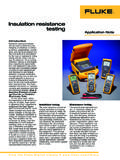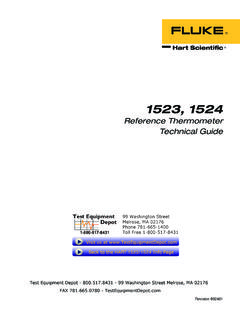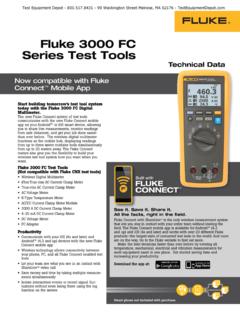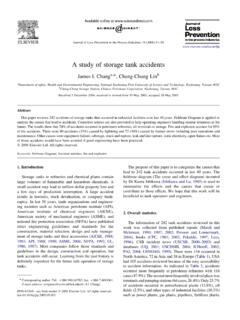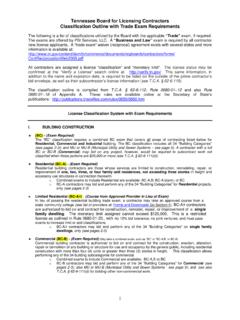Transcription of Getting Down to Earth - Electronic Test Equipment
1 Getting down to EarthA practical guide to Earth resistance testingTest Equipment Depot - - 5 Commonwealth Ave - Woburn MA 01801 Getting down to EarthIntroductionNothing is quite so common or abundantly available throughout the world as the Earth s soil. While you likely think of soil as something to be tilled for planting or to be excavated for a building foundation, it also has an electrical property conductivity (or low resistance) that is put to practical use every day in industrial plants and speaking, Earth resistance is the resistance of soil to the passage of electric current. In reality, the Earth is a relatively poor conductor of electricity compared to normal conductors like copper wire. However, if the area of a path for current is large enough, resistance can be quite low and the Earth can be a good conductor.
2 It is the Earth s abundance and availability that make it an indispensible component of a properly functioning electrical resistance is measured in two ways for two important fields of use:1. Determining effectiveness of ground grids and connections that areused with electrical systems to protect personnel and Prospecting for good (low resistance) ground locations, or obtainingmeasured resistance values that can give specific information about whatlies some distance below the Earth s surface (such as depth to bed rock).It is not the intent of this manual to go too deeply into the theory and mathematics of the subject. If you re interested in learning more, there is a list of Additional Resources found at the back of this booklet which cover these in extensive detail. Rather, Getting down to Earth is written in a simple and easy-to-understand format for all industry users.
3 Testing covered in this manual can be carried out on large, complex Earth systems, including communications Earth systems and other difficult test environments. Testing is carried out in accordance with BS 7430 (Earthing), BS-EN-62305 ( lightning protection ) and IEEE Standard years of experience supplying instruments for the tests involved Megger can provide advice to help you perform specific tests. Upon request, we would also be happy to have a representative call you to discuss your specific application question(s). 3 Getting down to EarthIntroduction ..1 Safety ..5 SECTION IEarth Resistivity ..6 How Earth Resistivity is 6 Practical Example of Test Method ..8 Type of Soil Affects Resistivity ..9 Resistivity Decreases with Moisture and Dissolved Salts ..10 Effect of Temperature on Earth Resistivity ..12 Seasonal Variations in Earth 12 Determining a Good Electrode Location.
4 14 SECTION IIMeasuring Earth Resistance for Electrical Grounding Systems ..16 Factors That Can Change Your Minimum Earth Resistance ..17 Some Basic Definitions ..17 Factors Influencing Requirements for a Good Grounding System ..19 National Electrical Code Maximum Values ..21 Nature of an Earth 21 Principles Involved in Earth Resistance Testing ..23 Basic Test Methods for Earth Resistance ..26 Effects of Different Reference Probe Locations ..30 Bonding and 35 Test 36 Lazy Spikes ..37 Supplementary Tests ..38 How to Improve Earth Resistance ..39 Additional Test Methods: Clamp-On Method ..44 Advantages of Stakeless Testing ..47 Limitations of Stakeless Testing ..48 Cell Tower Ground Testing ..49 Attached Rod Technique (ART) ..50 TABLE OF CONTENTS Getting down to EarthGetting down to EarthGetting down to Earth4 Star Delta Method.
5 54 Determining Touch and Step Potential ..57 SECTION IIIA ccurately Measuring Earth Resistance for Large Ground Systems ..59 Testing Challenges in Large Ground Systems ..59 Addressing the Testing Challenges in Large Ground Systems ..60 Measurement of the Resistance of Large Earth -Electrode Systems: Intersecting Curves Method ..62 Test at a Large Substation ..63 General Comments ..64 Slope Method ..66 Four Potential Method ..69 APPENDIX I Nomograph Guide to Getting Acceptable Earth Resistance ..72 APPENDIX IIGround Testing Methods Chart ..74 GROUND TESTERS AVAILABLE FROM MEGGER ..76 GROUND TESTING ACCESSORIES AVAILABLE FROM MEGGER ..78 REFERENCES ..79 ADDITIONAL RESOURCES ..805 Getting down to EarthGetting down to Earth Getting down to EarthGetting down to EarthGetting down to Earth65 Commonwealth Ave Woburn, MA 01801 Phone 781-665-1400 Toll Free 1-800-517-8431 Visit us at is an inherent safety problem in Earth resistance testing that requires care and planning by the user of the test set.
6 The possibility exists that a fault in the power system will cause a high current to flow into the ground system while the test is in progress. This may cause unexpected high voltages to appear at the current and voltage probes and also at the terminals of the test set. This risk must be evaluated by the person responsible for the tests, taking into account the fault current available and expected step-and-touch potentials. IEEE Standard 80 entitled IEEE Guide for Safety in AC Substation Grounding fully covers this subject. (Other standards may prevail elsewhere in the world.)We recommend that the operator wear rubber protective gloves (ANSI/ASTM D120 or equal) while handling connections and use a rubber safety mat (ANSI/ASTM D178 or equal) while operating the test down to EarthGetting down to EarthSECTION IEarth ResistivityThe term Earth resistivity expressed in ohm-centimeters (abbreviated ohm-cm) is one basic variable affecting resistance to Earth of an electrode system.
7 Fortunately, the actual value of Earth resistivity does not need to be measured in order to check the electrode Earth resistance. Let s first consider other fields where the value of resistivity is measured, as well as some of the factors affecting it that are of interest in Earth resistivity measurements can be used conveniently for geophysical prospecting to locate ore bodies, clays, and water-bearing gravel beneath the Earth s surface. The measurement can also be used to determine depth to bed rock and thickness of glacial of Earth resistivity are also useful for finding the best location and depth for low resistance electrodes, as well. Such studies are made, for example, when a new electrical unit is being constructed, such as: a generating station, substation, transmission tower, or telephone central , Earth resistivity may be used to indicate the degree of corrosion to be expected in underground pipelines for water, oil, gas, gasoline, etc.
8 In general, spots where the resistivity values are low tend to increase corrosion. This same kind of information is a good guide for installing cathodic Earth Resistivity is MeasuredTo measure Earth resistivity, a four-terminal instrument is used, along with four small-sized electrodes - driven down to the same depth and equal distances apart in a straight line (Fig. 1). Four separate lead wires connect the electrodes to the four terminals on the instrument, as shown. Hence, the name of this test: the four-terminal method. Getting down to EarthGetting down to EarthGetting down to Earth8Dr. Frank Wenner of the Bureau of Standards (now NIST) developed the theory behind this test in 1915 [1]. He showed that, if the electrode depth (B) is kept small compared to the distance between the electrodes (A)1, the following formula applies: = 2 ARwhere is the average soil resistivity to depth A in ohm-cm, is the constant , A is the distance between the electrodes in cm, and R is the Megger Earth tester reading in other words, if the distance A between the electrodes is 4 ft, you obtain the average Earth resistivity to a depth of 4 ft as follows:1.
9 Convert the 4 ft to centimeters to obtain A in the formula:4 x 12 x cm = 122 cm2. Multiply 2 A to obtain a constant for a given test setup:2 x x 122 = 766 Now, for example, if your instrument reading is 60 , the Earth resistivity would be 60 x 766, or 45,960 are other methods for measuring soil resistivity such as the Schlumberger method. However, the Wenner method is the most popular in the electric power 1: Four-terminal method of measuring Earth resistivity1B = 1/20A is generally recommended9 Getting down to EarthGetting down to EarthPractical Example of Test MethodA petroleum company had a 10-in. pipeline 6300 ft long running through rugged terrain [2]. After a corrosion leak, they wanted to check out Earth resistivity along the line. Low-resistance spots would most likely require attention. They used a Megger Earth tester to make a survey along the , the average depth of the pipeline was found from a profile map.
10 It was 4 ft, so four electrodes were tied together 4 ft apart with strong cotton cord. They decided to check soil resistivity every 20 ft along the line. Fig. 2 shows a portion of the results; pit depth corrosion and Megger Earth tester readings are plotted for points along the pipeline. Note that for low resistance readings, more corrosion was 2: Earth resistivity survey of pipeline shows where corrosion is most likely to occur [2]. Getting down to EarthGetting down to EarthGetting down to Earth102 US Bureau of Standards Report 108 Type of Soil Affects ResistivityWhether a soil is largely clay or very sandy, for example, can change the Earth resistivity a great deal. It isn t always easy to define exactly what s in a given soil; clay can cover a wide variety of soils. Therefore, we cannot say that any given soil has a resistivity of so many ohm-cm.
